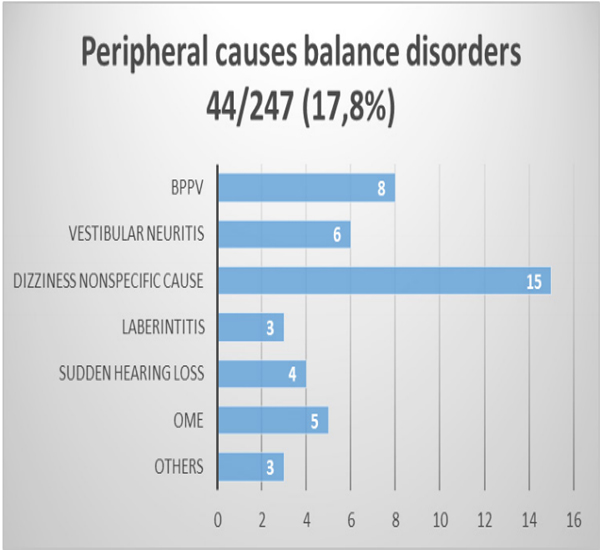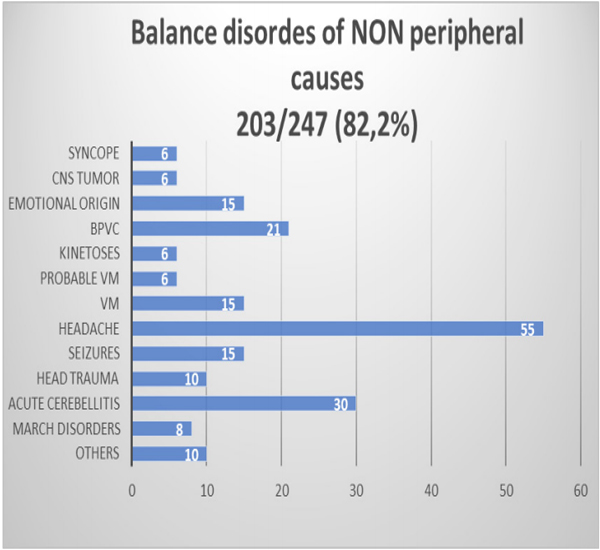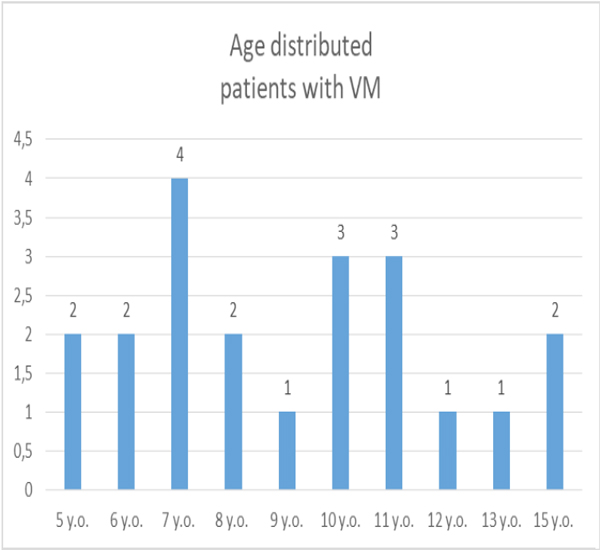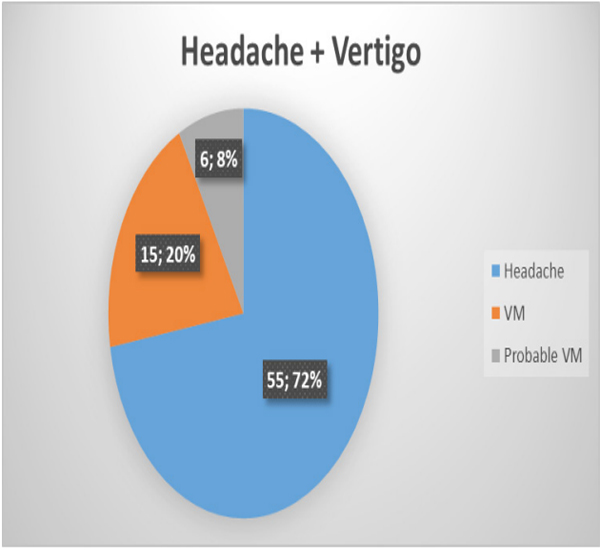Previous Issues Volume 3, Issue 1 - 2018
Vestibular Pathology in Pediatric Population Relevance of Vestibular Migraine
Sommerfleck PA1, Gonzalez Macchi ME1, De Bagge MD1, Bernaldez PC1, Carmona S2*
Corresponding Author: Carmona Sergio, INEBA Instituto de Neurociencias de Buenos Aires, Argentina, E-Mail: [email protected]
Received Date: 10 Apr 2018 Accepted Date: 29 Apr 2018 Published Date: 04 May 2018
Copyright © 2018 Carmona S
Citation: Carmona S, Sommerfleck PA, Gonzilez Macchi ME, De Bagge. et al. (2018). Vestibular Pathology in Pediatric Population Relevance of Vestibular Migraine. Mathews J Pediatr. 3(1): 011.
Background:Two of the most frequent symptoms in neurological consultation are headache and dizziness. Both have in common a multiplicity of etiologic causes as well as the need for an adequate symptomatic examination in order to make the correct diagnosis. These symptoms, when they appear at a pediatric age, are usually very troubling for the parents and, sometimes, disabling for the patient.
Objetives: To establish the prevalence of vestibular migraine (VM) in our series of pediatric patients.
Study Design: A retrospective, observational, descriptive, and cross-sectional study was performed.
Population: Patients aged 1-18 years who consulted the Otolaryngology Department of a Pediatric Tertiary-Care Hospital because of balance disorders between June 2014 and June 2017.
Results:Two hundred and forty seven patients 1-18 y.o. were included in the study; 123/247 (49%) girls y 124/247 (51%) boys. The median age was 9 years.
Within this group of studied patients 76/247 (30%) referred vestibular symptoms and headaches. Fifteen of them (20% - 15/76) met the diagnostic criteria for definite VM and 6/76 (8%) met the criteria for probable VM, i.e. 21/76 (28%) patients are included under this condition. This represents 8.5% (21/247) of the total sample included in this work. Fifty five patients 55/76 (76%) do not meet the VM criteria.
A family history of migraine is relevant data to be considered in this group of patients. 100% (15/15) of the patients with definite vestibular migraine had a family history of migraine.
Benign Paroxysmal Vertigo of Childhood (BPVC) is a migraine equivalent: 21/247 (8.5%) patients present this pathology in our series.
Thus, 21 patients with a VM diagnosis and 21 patients with BPVC. (Total: 42/247-17%- patients)
Conclusions: It can be established that, out of all children who consult due to "headache" associated to balance disorders, only a percentage below 10% meet the criteria for VM. The simple association of both symptoms does not define this pathology.
Balance Disorders; Vertigo; Dizziness; Vestibular Migraine; Childhood.
INTRODUCTION
Two of the most frequent symptoms in neurological consultation are headache and dizziness [1]. Both have in common a multiplicity of etiologic causes as well as the need for an adequate symptomatic examination in order to make the correct diagnosis. These symptoms, when they appear at a pediatric age, are usually very troubling for the parents and, sometimes, disabling for the patient.
The relationship between vestibular symptoms and migraine was first described in adults by Kayan and Hood in 1984 [2]. In 2001 Neuhauser and Lempert formally described the first diagnostic criteria.
The relationship between vertigo and migraine in children was first acknowledged by Basser in 1964 [3] when he described benign paroxysmal vertigo of childhood.
The HEADACHE-VERTIGO association is a very frequent combination which, many times, may confuse the general practitioner when trying to make the correct diagnosis.
The aim of this work is to determine the prevalence of VM in our pediatric patient's series (in those cases where it is possible to assess the fulfillment of this pathology established criteria).
MATERIAL AND METHODS
A retrospective, observational, descriptive, and cross-sectional study was conducted in patients 1-18 y.o. who consulted the Otolaryngology Department of a Pediatric Tertiary-Care Hospital because of balance disorders (vertigo, dizziness, instability) between June 2014 and June 2017.
All patients underwent a thorough anamnesis, otolaryngological examination, and vestibular testing. In all the cases (children over 4 y.o.) the complementary studies included a videonystagmography test (without caloric tests) and a video head impulse test for horizontal canals.
Patients were categorized based on the diagnostic criteria for vestibular migraine (VM) jointly formulated by the Vestibular Disorders Classification Committee of the Barany Society and the Classification Sub Committee of the International Headache Society (IHS) - Lempert 2012 [4] (table1).
Defined Vestibular Migraine
- At least 5 episodes of mild to severe intensity vestibular symptoms, lasting between 5 minutes and 72 hours
- Current or previous history of migraine, with or without aura according to the International Classification of Headache Disorders (ICHD)
- One or more migraine characteristics in at least 50% of the vestibular episodes.
- a. Headache with at least 2 of the following characteristics: unilateral, pulsating, mild to severe pain, worsened by routine physical activity b. Photophobia and phonophobia c. Visual aura
- The symptoms cannot be attributed to any other vestibular disease nor to an ICHD diagnosis.
Probable Vestibular Migraine
Table 1: Vestibular Migraine Diagnostic Criteria.
- At least 5 episodes of mild to severe intensity vestibular symptoms, lasting between 5 minutes and 72 hours
- Only one of B and C vestibular migraine criteria (history of migraine o migraine characteristics during the episode) is fulfilled.
- The symptoms cannot be attributed to any other vestibular disease nor to an ICHD diagnosis.
Current classification includes defined VM and probable VM. Diagnosis is based on recurring vestibular symptoms, a positive history of migraine and a temporal association between vestibular and migraine symptoms and exclusion of other causes for vestibular symptoms.
It is worth mentioning that in 1-5 y.o. children who do not present a clinical picture as florid as the one described for VM, benign paroxysmal vertigo of childhood (BPVC) is the most frequent pathology; which is anyhow considered a migraine manifestation [5-7].
International Headache Society BPVC Diagnostic Criteria [8] (Table 2.)
Probable Vestibular Migraine
Table 2: Vestibular Migraine Diagnostic Criteria.
- At least 5 episodes fulfilling B and C criteria
- Vertigo that appears with no aura, of maximum intensity at onset and which is spontaneously solved within minutes and with no loss of consciousness.
- At least one of the following associated signs or symptoms: 1- Nystagmus 2- Ataxia 3- Vomiting 4- Paleness 5- Fear
- Normal neurological exam and normal auditory and vestibular functions between episodes
- The symptoms CANNOT be attributed to any other condition.
Clinical data were collected from the medical records of the patients.
The obtained data was collected in an Excel 2010 data base and analyzed using the SPSS statistical package (version 15.0).
RESULTS
Two hundred and forty seven patients ages 1-18 y.o. were included in our study; 123/247 (49%) girls y 124/247 (51%) boys. The median age was 9 years.
Figures 3 and 4 show the most frequent causes of balance alterations in childhood.
Figure 3: Peripheral causes balance disorders
BPPV: benign paroxysmal positional vertigo. OME: otitis media with effusion. SHL: sudden hearing loss.
Our case is 14 months old, she was well until the age of three months when she started to have recurrent chest infection, abnormal movements as well as failure-to-thrive. Most of these chest infection attacks required emergency department visit and sometimes admissions. For that reason, she did not complete her vaccination schedule as she was being unwell most of the time.
Figure 4: Balance disorders of NON Peripheral cause.
BPVC: vestibular migraine HT: head trauma
Within this group of studied patients 76/247 (30%) referred vestibular symptoms and headaches. Fifteen of them (20% - 15/76) met the diagnostic criteria for defined VM and 6/76 (8%) met the criteria for probable VM, i.e. 21/76 (28%) patients are included in this condition. (Criteria table in Material and Methods section). Ten of the 21 patients were girls and 11/21 were boys. Age distribution is shown in Table 3.
This represents 8.5% (21/247) of the total sample considered in this work. Fifty five patients 55/76 (76%) do not meet the VM criteria. (Graphic 1).
Table 3: Age distribution in patients with diagnosis of VM.
A family history of migraine is relevant data to be considered in this group of patients. 100% (15/15) of the patients with defined vestibular migraine had a family history of migraine. Out of the 6 patients with probable vestibular migraine criteria, only one denied having a family history of migraine.
Graphic 1: Patients who consult due to HEADACHE + VERTIGO
As we have previously mentioned, BPVC is a migraine equivalent: 21/247 (8.5%) patients present this pathology in our series. 71.4% (15/21) of those patients have a family history of migraine.
Thus, 21 patients with a VM diagnosis and another 21 patients with BPVC. (Total: 42/247 patients)
DISCUSSION
Headache is one of the most frequent causes of consultation in neuropediatrics. It is common during childhood and even more during adolescence. Before puberty, it is predominant in boys, and after puberty, in girls [9]. This condition was the prevailing reason for consultation in all age groups [10-11].
According to Aynur Ozge, Abu-Arafeh et al [12]: headache disorders in children have specific features different from those in adults: clinical characteristics, risk factors and etiologies were found to be age-dependent.
A thorough analysis of those children who consult due to "headache" associated to dizziness helps us determine that only 8.5% meet the criteria set for VM. A high percentage of patients who consult due to "headaches and vertigo" are left out of this classification; the association of both symptoms does not imply vestibular migraine.
In children under the age of 5, the percentage of BPVC (migrainous equivalent, as it has already been mentioned) also coincidentally represents 8.5% of the cases.
BPVC appears in children without aura and with no triggers. It presents with sudden and brief vertigo episodes which are spontaneously solved. It is hard to obtain an adequate description in small children, thus the need to observe the signs that accompany it: instability, fear of walking, crying, paleness, vomiting, nystagmus. The first episode may appear between the ages of 1 and 4, though there are descriptions of later cases. These children rarely consult in the acute stage, and it is usually the reappearance of symptoms what calls the parent's attention who then visit the specialist. Repetitive crisis, with no signs of othologic pathologies and of spontaneous and complete resolution after the crisis, are important factors.
A good anamnesis and oto-neurologic assessment are important and, in some cases, an electroencephalogram may make it possible to differentiate it from vertigo of epileptic origin; neuroimaging is useful and precise when symptoms persist or when neurological deficits appear [13].
MV presents with episodes of vertigo or instability, has a sudden onset and is accompanied by nausea and / or vomiting, intolerance to changes in position and head movements [14]. Headache - when present - may precede, accompany or follow dizziness. The symptoms can last from minutes to hours. Family history is highly prevalent in these patients.
As regards treatment of a pediatric population, it is important to consider which patients to treat and when we begin treatment.
First, we need to evaluate the hygienic-dietary conditions, which are not the same as in adults. In children, crises usually increase when the sleep pattern is altered (the child goes to bed late, does not sleep enough, schedules are not respected), due to stress or to some foods.
The first choice is the use of common analgesics If the episodes are frequent (more than twice a week), long-lasting, or do not respond to symptomatic treatment, a 3-6 month prophylactic treatment may be started.
In the case of BPVC, the main thing is to reassure the parents. Cases requiring oral medication are the less frequent ones. The criteria to use is similar to those for VM (as this is a migraine equivalent)
CONCLUSION
It can be established that, out of all children who consult due to "headache" associated to balance disorders, only a percentage below 10% meet the criteria for VM. The simple association of both symptoms does not define this pathology.
Both VM and BPVC are diagnostic of exclusion, which is very important in pediatric population to rule out other pathologies, mainly if there is any unusual manifestation.
This research was approved by the Ethical Committee and by the Direccion Asociada de Docencia e Investigacion of the Hospital de Pediatria "Prof Dr. Juan P Garrahan".
Oral informed consent to participate in the study was given by the parent or legal guardian of each child.
INTEREST CONFLICTS :Nothing to declare.
REFERENCES
- Porta - Etessam J. (2007). Migraine and vertigo. Rev Neurol. 44(8): 490-493.
- Kayan A and Hood DJ. (1984). Neuro-Otological Manifestation of Migraine. Brain. 107:1123-1142.
- Basser LS. (1964). Bening Paroxismal Vertigo of Chilhood: a variety of vestibular neuronitis. Brain; (87) 141-152.
- Lempert T, Olesen J, Waterston J, Furman J, et al. (2012). Vestibular migraine: Diagnostic criteria. Consensus document of the Barany Society and the International Headache Society. Journal of Vestibular Research. 22(4): 167- 72.
- Perez Plasencia D, Beltran Mateos LD, Del Canizo Alvarez A, et al. (1998). Vertigo Benigno Paroxistico de la Infancia. Acta Otorrinolaring. Esp. 49(2): 151-155.
- Sanz EM and Barona de Guzman R. (2007). Vertigo paroxistico benigno infantil: categorizacion y comparacion con el vertigo posicional paroxistico benigno del adulto. Acta Otorrinolaringol Esp. 58(7): 296-301.
- Marcelli V, Russo A, Cristiano E, Tessitore A. et.al. (2015). Benign paroxismalvertigo of childhood: a 10-year observational follow-up. Cephalalgia; 35(6): 538-544.
- (2013). Headache classification committee of the international headache society. The international classification of headache disorders, 3rd edition (beta version). Cephalalgia. 33: 629-808.
- Arroyo H.A. (2003). Cefalea en la infancia y adolescencia. Clasificacionetiopatogenica. Rev. Neurol. 37(4): 364-370.
- Brodsky JR, Cusick BA and Zhou G. (2016). Evaluation and management of vestibular migraine in children: Experience from a pediatric vestibular clinic. European Journal of Paediatric Neurology. 20(1): 85-92.
- Carmona S and Bruera O. (2009). Prophylatic treatment of migraineand migraine clinical variants with topiramate: an update. Therapeutics and clinical risk management. 5: 661-669.
- Ozge A, Abu-Arafeh I, Gelfand AA, Goadsby PJ, et al. (2017). Expert's opinion about the pediatric secondary headaches diagnostic criteria of the ICHD-3 beta. The Journal of Headache and Pain 18:113.
- Sanchez S, Carpintero A. Vertigo Paroxistico Benigno. et al. (2014). Trastornos paroxisticos no epilepticos en la infancia. (255-258) Barcelona - Espana. Viguera Editores SLU.
- Sergio Carmona-Jorge Kattah. (2017). Manejo del Sindrome Vestibular agudo Editorial Akadia 1 edicion 2017. Capitulos 8y9: migrana vestibular y SVA en la infancia y la adolescencia. 87-96.



